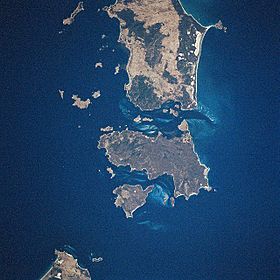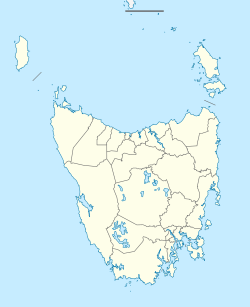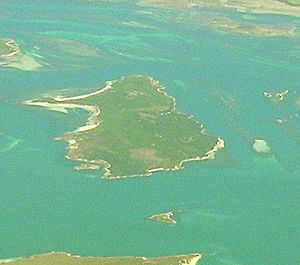Great Dog Island (Tasmania) facts for kids
|
Nickname: Big Dog Island
|
|
|---|---|

Great Dog Island (centre) from space, January 1997
|
|
|
Location of the Great Dog Island in Bass Strait
|
|
| Geography | |
| Location | Bass Strait |
| Coordinates | 40°18′00″S 147°54′36″E / 40.30000°S 147.91000°E |
| Archipelago | Great Dog Group, part of the Furneaux Group |
| Area | 3.75 km2 (1.45 sq mi) |
| Administration | |
|
Australia
|
|
| State | Tasmania |
| LGA | Municipality of Flinders Island |
| Largest settlement | Great Dog Island village (pop. 10) |
| Demographics | |
| Population | 10 |
| Pop. density | 2.67 /km2 (6.92 /sq mi) |
Great Dog Island, also known as Big Dog Island, is a small island in Australia. It's part of a group of islands called the Great Dog Group, which is inside the larger Furneaux Group. This island is made of granite and covers about 354 hectares. You can find it in Bass Strait, south of Flinders Island and north of Cape Barren Island, in Tasmania.
Great Dog Island is privately owned. Over time, things like farm animals eating plants, fires, and the arrival of new animal species have caused problems for the island's natural environment. The island is very important for birds. It's part of the Franklin Sound Islands Important Bird Area, which means it's a special place where more than 1% of the world's population of six different bird species live.
Contents
Island History
Early Visits to the Island
George Augustus Robinson, a well-known explorer, visited Great Dog Island in the 1830s. He wrote that people who hunted seals were collecting short-tailed shearwater birds there in 1837. These birds were often collected for their meat and oil.
The Great Dog Island Group
Islands in the Group
Great Dog Island is the largest island in a small group of islands. This group is called the Great Dog Island Group. It includes several smaller islands and reefs nearby.
Here are the islands and reefs that are part of the Great Dog Island Group:
- Great Dog Island
- Little Green Island
- Billy Goat Reefs
- South East Great Dog Islet
- Little Dog Island
- Samphire Island
- Fisher Island
- Fisher Island Reef
- Briggs Islet
- Spences Reefs
Plants and Animals
Island Plants
Most of the plants on Great Dog Island are a type of grass called Poa poiformis. This grass grows well because of the many short-tailed shearwater birds that dig burrows and help fertilize the soil. Fires that happen regularly also help this grass grow.
On the north-eastern side of the island, there's a special area with a mix of trees. This kind of forest is rare in the Furneaux Group. It has manna gum trees and Acacia verticillata plants. You can also find different types of Allocasuarina, Melaleuca, and Leptospermum shrubs there.
Island Animals and Their Reproduction
Many interesting animals live on Great Dog Island. It's a very important place for seabirds and waders to breed.
Some of the birds that nest and raise their young here include:
- Short-tailed shearwater: About 300,000 pairs of these birds live on the island.
- White-faced storm-petrel
- Sooty oystercatcher
- Pied oystercatcher
The island is also home to several types of reptiles:
- Metallic skink
- Spotted skink
- Eastern three-lined skink
- Eastern blue-tongued lizard
- Lowland copperhead (a type of snake)
- Tiger snake (another type of snake)
A native mammal found on the island is the rakali, which is a water rat. However, there are also some animals that were brought to the island by people and are not native. These include mice, rats, and feral cats.



